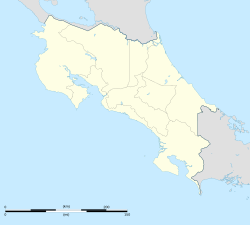Guápiles, Pococí facts for kids
Quick facts for kids
Guápiles
|
|
|---|---|
|
District
|
|
| Country | |
| Province | Limón |
| Canton | Pococí |
| Creation | 19 September 1911 |
| Area | |
| • Total | 222.63 km2 (85.96 sq mi) |
| Elevation | 262 m (860 ft) |
| Population
(2011)
|
|
| • Total | 36,469 |
| • Density | 163.810/km2 (424.266/sq mi) |
| Time zone | UTC−06:00 |
| Postal code |
70201
|
Guápiles is a district found in the Pococí area of the Limón province in Costa Rica. It's a busy and important place in the country.
Contents
What's in a Name?
The name Guápiles might come from two rivers that flow on both sides of the town. People used to say these rivers were "Guapes," which means "twins."
The name of the larger area, Pococí, comes from a native leader called a "cacique." This cacique lived here when the Spanish first arrived. Other important caciques in the region were Camaquiri and Cocorí. You can find their names in old history books and stories from Costa Rica.
A Look Back in Time
Guápiles was officially created on September 19, 1911. This happened through a special law called Ley 12.
Exploring Guápiles' Geography
Guápiles covers an area of about 222.63 square kilometers. It sits at an elevation of 262 meters above sea level.
The town is often called the main entrance to the Caribbean side of Costa Rica. It's an important stop for travelers heading to the coast.
Guápiles' Climate
Guápiles has a tropical climate. This means it's generally warm all year round. It also gets a lot of rain, especially during certain months.
| Climate data for Guapiles | |||||||||||||
|---|---|---|---|---|---|---|---|---|---|---|---|---|---|
| Month | Jan | Feb | Mar | Apr | May | Jun | Jul | Aug | Sep | Oct | Nov | Dec | Year |
| Mean daily maximum °C (°F) | 27.5 (81.5) |
27.8 (82.0) |
28.5 (83.3) |
29.1 (84.4) |
29.7 (85.5) |
29.3 (84.7) |
28.6 (83.5) |
28.9 (84.0) |
29.4 (84.9) |
29.1 (84.4) |
28.3 (82.9) |
27.8 (82.0) |
28.7 (83.6) |
| Mean daily minimum °C (°F) | 18.6 (65.5) |
18.9 (66.0) |
19.4 (66.9) |
20.1 (68.2) |
20.9 (69.6) |
21.1 (70.0) |
21.0 (69.8) |
20.8 (69.4) |
20.7 (69.3) |
20.6 (69.1) |
20.4 (68.7) |
19.5 (67.1) |
20.2 (68.3) |
| Average precipitation mm (inches) | 276.1 (10.87) |
238.5 (9.39) |
215.4 (8.48) |
241.5 (9.51) |
430.4 (16.94) |
443.7 (17.47) |
509.8 (20.07) |
474.6 (18.69) |
375.8 (14.80) |
448.6 (17.66) |
470.9 (18.54) |
451.9 (17.79) |
4,577.2 (180.21) |
| Average precipitation days | 20.6 | 17.4 | 17.4 | 17.6 | 22.3 | 23.4 | 25.4 | 25.4 | 22.9 | 23.2 | 22.5 | 21.9 | 260 |
| Source: World Meteorological Organization (temperature 1971–1998, precipitation 1964–1998) | |||||||||||||
How Many People Live Here?
| Historical population | |||
|---|---|---|---|
| Census | Pop. | %± | |
| 1927 | 1,236 | — | |
| 1950 | 4,636 | 275.1% | |
| 1963 | 7,616 | 64.3% | |
| 1973 | 7,297 | −4.2% | |
| 1984 | 11,216 | 53.7% | |
| 2000 | 27,368 | 144.0% | |
| 2011 | 36,469 | 33.3% | |
|
Instituto Nacional de Estadística y Censos |
|||
According to the 2011 census, Guápiles had a population of 36,469 people. This number shows how the district has grown over the years.
Towns and Neighborhoods
The main city in the district is also called Guápiles. It's one of the biggest cities outside of Costa Rica's Central Valley.
Guápiles is about 64 kilometers northeast of San José, the capital city. You can reach it by taking Route 32. The city of Limón is 99 kilometers to the east.
Here are some of the smaller places that make up the district:
- City: Guápiles
- Neighborhoods (Barrios): Cecilia, Diamantes, Emilia, Floresta, Coopevigua (1,2,3), Garabito, Palmera, Los Sauces, La Urba, Toro Amarillo
- Villages (Poblados): Blanco, Calle Ángeles, Calle Gobierno, Corinto, Flores, Marina, Prado (part), Rancho Redondo, San Rafael
What People Do for Work
Today, like in many parts of the Caribbean coast, the main jobs in Guápiles are in farming. People grow crops like bananas and pineapples. They also grow basic grains and raise livestock (farm animals).
The area is also known for its beautiful scenery. This makes it a great place for tourists to visit and enjoy nature.
Getting Around Guápiles
Roads and Routes
Several important roads connect Guápiles to other parts of Costa Rica. These roads help people and goods move in and out of the district.
The main road routes that pass through Guápiles are:
See also
 In Spanish: Guápiles para niños
In Spanish: Guápiles para niños


